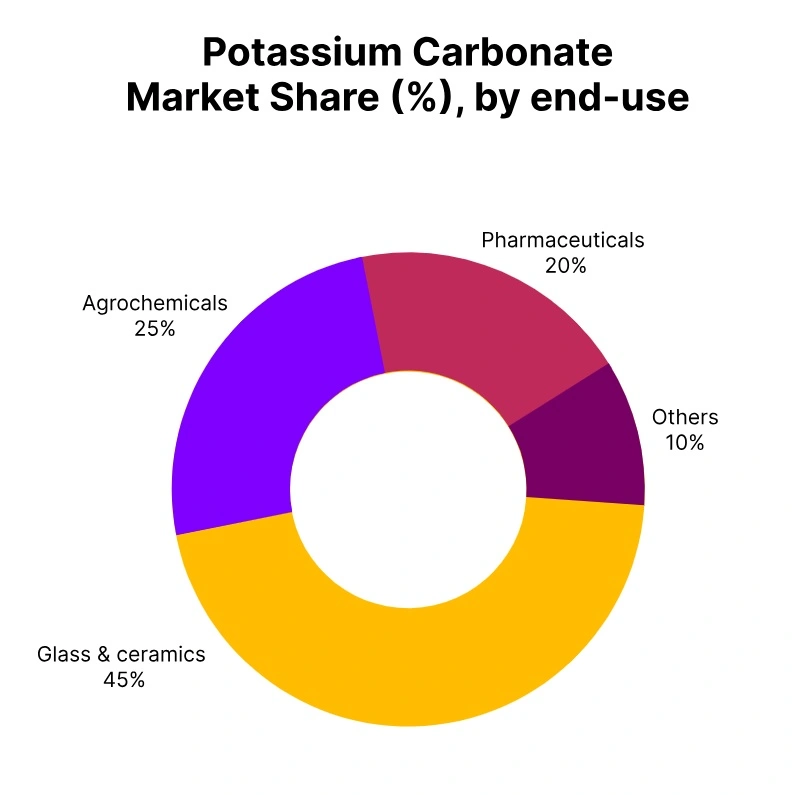Price-Watch’s most active coverage of Potassium Carbonate price assessment:
- (99.5% min) Industrial Grade Powder FOB Busan, South Korea
- (99.5% min) Industrial Grade Powder CIF Santos (South Korea), Brazil
- (99.5% min) Industrial Grade Powder CIF Mersin (South Korea), Turkey
- (99.5% min) Industrial Grade Powder CIF Jakarta (South Korea), Indonesia
- (99.5% min) Industrial Grade Powder CIF Houston (South Korea), USA
- (99.5% min) Industrial Grade Powder CIF Nhava Sheva (South Korea), India
Potassium Carbonate Price Trend Q3 2025
In Q3 2025, global Potassium Carbonate price trends varied, resulting in a average price increase of approximately 4.7% over Q2. Brazil incurred the largest increase of 15% due to strong restocking and agricultural demand. India grew by an average of 4% as logistics improved and consumption increased.
South Korea, Turkey, and Indonesia experienced increases of 3% due to stable demand from the agricultural and pharmaceutical industries. The USA was the only market to demonstrate a minimal decline of 0.2% given slow demand and inventory levels.
Most demand trends in all the above regions experienced stable imports from South Korea, consistent freight trends, and stable downstream demand. Prices exhibited a generally consistent price in September 2025, consistent with price growth or stability over the quarter.
South Korea
Potassium Carbonate Export Prices FOB Busan, South Korea, Grade- (99.5% min) Industrial Grade Powder.
In the third quarter of 2025, the Potassium Carbonate price in South Korea experienced a significant uptick compared to the previous quarter, with the commodity price increasing 3% over the previous quarter (Q2 2025). Potassium Carbonate price trend in South Korea was aided on the one hand by persistent demand from overseas and a modest rebounding of shipments in Asia and Europe.
Exporters capitalized on steady production and favorable freight conditions that contributed to price momentum. Demand from downstream markets, especially agriculture and pharmaceuticals, remained solid and supported continued exports.
Additionally, the ongoing consistent purchasing from global consumers for potassium-based fertilizers and pharmaceutical grade carbonates contributed positively to prices. Potassium Carbonate prices in September of 2025 remained firm with stable raw material input costs and uninterrupted export shipping logistics.
India
Potassium Carbonate Import prices CIF Nhava Sheva, India, Grade- (99.5% min) Industrial Grade Powder.
According to Price-Watch, in the third quarter of 2025, Potassium Carbonate price in India increased by 4% compared to the previous quarter. This increase was supported by demand stability from both agriculture and pharmaceuticals. The Potassium Carbonate price trend in India showed modest recovery from the Q2 dip on the back of improved procurement sentiment and more normal logistics after disruptions from monsoon conditions.
Imports from South Korea remained stable, with buyers taking advantage of competitive CIF rates. Demand remained firm across key industries despite challenges from the global economy. September 2025 Potassium Carbonate price in India remained steady, consistent with the quarterly trend. Inventory replenishment and continued demand dictated market activity, with market participants monitoring input costs and overseas transit times.
USA
Potassium Carbonate Import Prices CIF Houston, USA, Grade- (99.5% min) Industrial Grade Powder.
In the United States, the Potassium Carbonate price in Q3 2025 decreased slightly 0.2% from the previous quarter, indicating a flat market and lack of fluctuation. Potassium Carbonate price trend in the United States was influenced by consistent purchasing from agriculture and pharmaceuticals and stable inventory levels without any major change in purchasing behavior.
Import activity from South Korea continued to proceed well, while domestic buyers were cautious due to economic uncertainties. The Potassium Carbonate price was stable in September 2025 with the quarterly trend. Limited change in demand, as well as sufficient inventory supply, contributed to minimal price movement in the market.
Turkey
Potassium Carbonate Import prices CIF Mersin, Turkey, Grade- (99.5% min) Industrial Grade Powder.
The Potassium Carbonate price in Turkey saw a 3% increase in Q3 2025 compared to Q2 2025, following stable market activity. Potassium Carbonate price trend in Turkey was supported by regular offtakes from end-use sectors, especially agriculture and pharmaceuticals, resulting in stable consumption.
Imports from South Korea continued with little disruption, although some minor fluctuations in container freight rates affected final pricing. Unlike in prior quarters, buyers were active in replenishing restocking due to steady pricing and potential upticks.
The Potassium Carbonate price nationwide in September 2025 remained firm. Continued confidence in the market was assisted by stable end-user demand with no significant supply chain disruptions, notwithstanding recent currency fluctuations affecting some procurement activities.
Brazil
Potassium Carbonate Import prices CIF Santos, Brazil, Grade-(99.5% min) Industrial Grade Powder.
In Brazil, during Q3 2025, Potassium Carbonate price skyrocketed 15% from Q2, the largest price jump from other importing countries. Potassium Carbonate Price trend in Brazil were supported by restocking demand and some recovery in agricultural activities, with additional support from the pharmaceutical sector. Brazilian potential importers were also reliant on South Korean suppliers, with limited availability from nearby sources, and the declining local currency led to higher CIF costs.
Potassium Carbonate prices trend remained elevated in September 2025, with bullish sentiment present in the market. Buyers were quick to secure stock ahead of the Q4 timeframe, and pricing was supported by tight supply and seasonal agricultural demand.
Indonesia
Potassium Carbonate Import prices CIF Jakarta, Indonesia, Grade-(99.5% min) Industrial Grade Powder.
In the third quarter of 2025, a 3% increase in Potassium Carbonate prices versus the prior quarter indicated a fairly stable market performance. Potassium Carbonate price trends in Indonesia were steady due to sufficient import volumes from South Korea and consumption in the agricultural and pharmaceutical sectors. Demand showed resilience due to improved logistics and favorable weather patterns in many of the key agricultural zones.
The Potassium Carbonate price for September 2025 reflected the quarterly trend, with Indonesian buyers cautious but optimistic and planning to maintain their inventory levels without being overcommitted.
The inherent demand factors were stable, with supply maintaining some reliability, which kept the market price volatility in check. In fact, the market was in a relatively stable position for the upcoming quarter.





